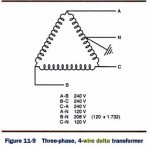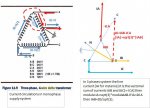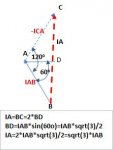AHarb
Member
- Location
- Atlanta, GA
Hi,
I'm trying to figure out how to calculate the maximum possible demand through a 9S meter served by a four-wire delta bank. I know the meter is capable of a maximum 20 amps per phase. If we assume there are 20 amps per phase and we have a unity power factor (cos (theta) = 1), which of the 3 voltages should we use in the power calculation? Below is a diagram showing the four-wire delta bank and the voltages.

Any help would be appreciated.
Thanks in advance.
Adam
I'm trying to figure out how to calculate the maximum possible demand through a 9S meter served by a four-wire delta bank. I know the meter is capable of a maximum 20 amps per phase. If we assume there are 20 amps per phase and we have a unity power factor (cos (theta) = 1), which of the 3 voltages should we use in the power calculation? Below is a diagram showing the four-wire delta bank and the voltages.

Any help would be appreciated.
Thanks in advance.
Adam



